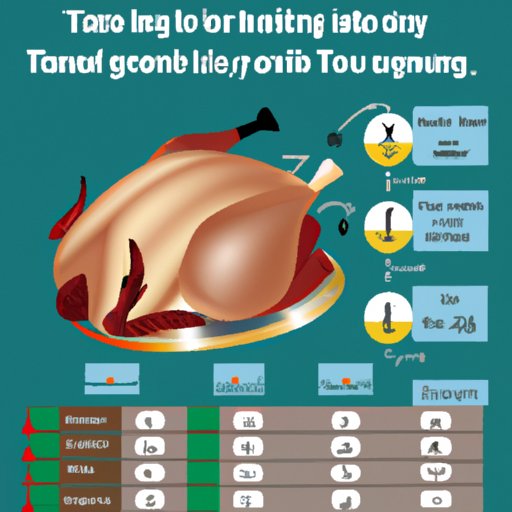
Introduction
Thanksgiving is a time where families come together to share a meal and create lasting memories. At the center of the Thanksgiving table is the star of the show: the turkey. Cooking a turkey can be intimidating for many people, but it doesn’t have to be. In this article, we will guide you through the steps to baking the perfect turkey, from preparation to serving.
Step-by-Step Guide
Before baking your turkey, there are a few preparations to complete. Begin by removing any giblets and ensuring the turkey is fully thawed, and then take the turkey out of the fridge and let it come up to room temperature for 30 minutes. Preheat the oven to 325°F and place the turkey in a roasting pan, breast side up. Brush the turkey with butter, herbs, and spices of your choice.
The general cooking time for a stuffed turkey is approximately 20 minutes per pound, while an unstuffed turkey is about 12-15 minutes per pound. It’s essential that the internal temperature of the turkey reaches 165°F. Check the temperature occasionally by inserting the thermometer into the thickest part of the turkey’s thigh without touching the bone. Once it has reached that temperature, take the turkey out of the oven and let it rest for at least 30 minutes before carving. Drizzle it with the pan drippings, and voila, you have the perfect turkey.
Temperature-Based Methods
Temperature plays an important role in determining how long to bake a turkey, and different baking techniques are available based on oven temperature. Preheat the oven to 375°F for a “hot and fast” cooking method, producing crispy, golden skin; otherwise, preheat to 325°F for a “low and slow” method, which produces moist and juicy meat. A meat thermometer is a turkey baker’s best friend and helps you determine the appropriate temperature for the bird to be fully cooked.
For a larger bird, the cooking time can be extended by covering it with foil, and for a smaller bird, it can be cooked uncovered to achieve the desired browning of the skin. The internal temperature of the stuffing must also reach 165°F before taking the turkey out of the oven.
Time-Saving Tips
Baking a turkey can be a time-consuming process, but there are a few tips to help you save time. Using a roasting bag reduces cooking time by 30 minutes and helps keep the turkey moist while cooking. Preparing the stuffing the night before and reheating it on Thanksgiving Day also saves time. Removing the turkey’s backbone allows it to lay flat, and it cooks faster.
Flavor Variations
Spice up your traditional turkey by using one of several flavor profiles, such as brining or using fruit juices. Brining the turkey before cooking it introduces moisture, salt, and flavor to the bird. Using fruit juices like apple cider or cranberry juice infuses flavor into the turkey while cooking. Cooking the turkey with different liquids like wine or cider is another great way to add flavor variations. Mix and match different flavor profiles to complement your side dishes.
Accompaniments
Pairing the turkey with complementary side dishes enhances the overall flavor profile of the meal. Some classic sides are sweet potato casserole, stuffing, cranberry sauce, green beans, and mashed potatoes. For those who want to serve vegan or vegetarian options, alternative sides like roasted Brussels sprouts, vegan stuffing, mashed cauliflower, or quinoa salad are healthy options.
Ask the Experts
Getting tips from professional chefs and home cooks is a great way to improve your turkey baking skills. Some professional chefs like to cook their turkey with the breast underneath to keep the meat from drying out, while others recommend rubbing the turkey with olive oil. Home cooks shared their tips, including stuffing the turkey with onions and garlic for extra flavor, placing the turkey on a bed of celery, or even putting a slice of bacon on the turkey breast for extra moisture.
Conclusion
Baking a turkey doesn’t have to be a daunting task anymore. The key to a juicy and delicious turkey is to have patience and follow the steps outlined in this article. Experimenting with different temperature-based methods, flavors, and side dishes can add excitement to your traditional Thanksgiving meal. We hope you have a successful, stress-free Thanksgiving, filled with lots of love, and memories that will last a lifetime.




